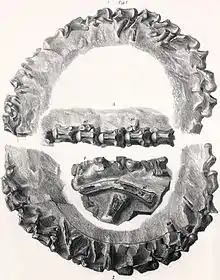Palaeophis
Palaeophis ('ancient snake') is an extinct genus of marine snake that is the type genus of the extinct snake family Palaeophiidae.
| Palaeophis | |
|---|---|
 | |
| Fossil vertebrae of Palaeophis maghrebianus from Khouribga (Morocco) | |
| Scientific classification | |
| Domain: | Eukaryota |
| Kingdom: | Animalia |
| Phylum: | Chordata |
| Class: | Reptilia |
| Order: | Squamata |
| Suborder: | Serpentes |
| Family: | †Palaeophiidae |
| Subfamily: | †Palaeopheinae |
| Genus: | †Palaeophis Owen, 1841 |
| Type species | |
| †Palaeophis toliapicus Owen, 1841 | |
| Species | |
|
Species
| |
Described species within this genus lived in the Eocene epoch, with some unnamed or questionable records from Cenomanian and Maastrichtian.[1] Fossils of species within this genus have been found in England, France, Denmark,[2] Morocco[3] and Mali.[4] Remains have also been found in North America, including Maryland and Virginia (from the early Eocene Nanjemoy Formation),[5] Georgia[6] and Mississippi.[7]
Description


These species varied broadly in size; Palaeophis casei is the smallest at 1.3 metres of length, while the largest species, Palaeophis colossaeus, is estimated to have been 8.1–12.3 m (27–40 ft) long based on isolated vertebrae,[4][8] making it one of the largest known snakes. However, most species of the genus were not as big.[9][10] There are many species of Palaeophis but it can be separated into two assemblages of species or grades. In which the primitive grade include species whose vertebrae are weakly laterally compressed and have less developed and low process of vertebrae. Subsequently the advanced grade are characterized by vertebrae presenting a strong lateral compression which translate to being much better adaption to aquatic life.
Biology
Species of Palaeophis were specialised aquatic animals, as their fossils occur primarily in marine strata, though at least some estuarine remains have also been found.[7] Different species are thought to have occupied different ecological niches.
Studies on Palaeophis vertebrae show a high degree of vascularisation, suggesting that it had a considerably faster metabolism and growth rate than modern snakes. This may suggest that palaeophiids, like other marine reptiles such as mosasaurs, might have developed towards endothermy.[3]
References
- Folie, Annelise; Mees, Florias; De Putter, Thierry; Smith, Thierry (2021-07-01). "Presence of the large aquatic snake Palaeophis africanus in the middle Eocene marine margin of the Congo Basin, Cabinda, Angola". Geobios. Proceedings of the PalEurAfrica project international symposium Evolution and Paleoenvironment of Early Modern Vertebrates during the Paleogene. 66–67: 45–54. doi:10.1016/j.geobios.2020.11.002. ISSN 0016-6995. S2CID 229411514.
- Kristensen, H. V.; Cuny, G.; Rasmussen, A. R.; Madsen, H (2012). "Earliest record of the fossil snake Palaeophis from the Paleocene/Eocene boundary in Denmark". Bulletin de la Société Géologique de France. 183 (6): 621–625. doi:10.2113/gssgfbull.183.6.621.
- Houssaye, Alexandra; Rage, Jean-Claude; Bardet, Nathalie; Vincent, Peggy; Amaghzaz, Mbarek; Meslouh, Said (2013). "New highlights about the enigmatic marine snake Palaeophis maghrebianus (Palaeophiidae; Palaeophiinae) from the Ypresian (Lower Eocene) phosphates of Morocco". Palaeontology. 56 (3): 647–661. doi:10.1111/pala.12008.
- Rage, J.-C. (1983). "Palaeophis colossaeus nov. sp. (le plus grand Seprent connu?) de l'Eocène du Mali et le problème du genre chez les Palaeopheinae". Comptes rendus de l'Académie des Sciences de Paris. 3 (296): 1741–1744.
- Blake, S. F. "Note on a vertebra of Palaeophis from the Eocene of Maryland." Journal of the Washington Academy of Sciences 31.12 (1941): 501-503.
- Parmley, Dennis, and Harold W. Reed. "Size and age class estimates of North American Eocene palaeopheid snakes." Georgia Journal of Science 61.4 (2003): 220.
- Holman, J. Alan. "Palaeophis casei, new species, a tiny palaeophid snake from the early Eocene of Mississippi." Journal of Vertebrate Paleontology 2.2 (1982): 163-166.
- McCartney, Jacob; Roberts, Eric; Tapanila, Leif; O'Leary, Maureen (2018). "Large palaeophiid and nigerophiid snakes from Paleogene Trans-Saharan Seaway deposits of Mali". Acta Palaeontologica Polonica. 63. doi:10.4202/app.00442.2017. ISSN 0567-7920. S2CID 59147071.
- Holman, J. Alan (1982). "Palaeophis casei, new species, a tiny palaeophid snake from the early Eocene of Mississippi". Journal of Vertebrate Paleontology. 2 (2): 163–166. doi:10.1080/02724634.1982.10011927. JSTOR 4522892.
- Rage, Jean-Claude; et al. (2003). "Early Eocene snakes from Kutch, Western India, with a review of the Palaeophiidae". Geodiversitas. Editions scientifiques du Muséum, Paris, France. 25 (4): 695–716. ISSN 1280-9659. Retrieved 12 May 2010.